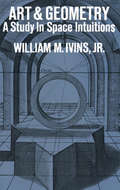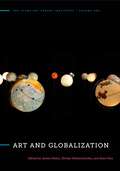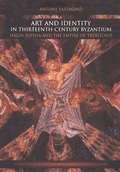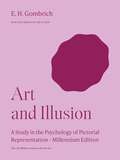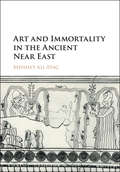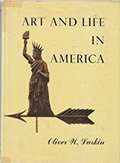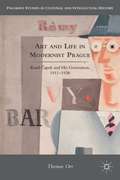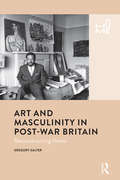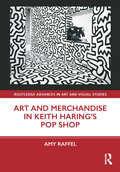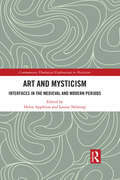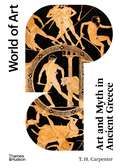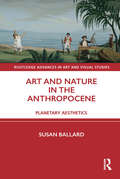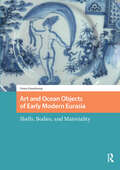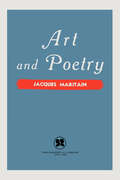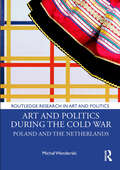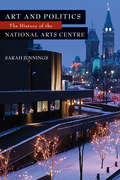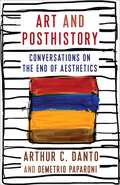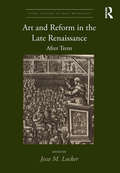- Table View
- List View
Art and Geometry: A Study in Space Intuitions
by William M. IvinsOne of Western civilization's jealously guarded myths is that of Greek cultural supremacy. In this controversial study, William Ivins shows that the limitations of the Greek worldview actually hampered the development of the arts and sciences and gives a stimulating history of the new ideas of the Renaissance, especially in painting and geometry, that freed us from ancient misconceptions. Beginning with the Greeks, the author explains for the general reader the differences between ancient and Renaissance painting and sculpture, proving that the curiously static quality of Greek art arose from a misunderstanding of the laws of perspective. He then shows how this misunderstanding was corrected by Alberti, Pelerin, Durer, and other Renaissance artists who provided the first fruitful investigations of perspective. From there to projective geometry was but a step, and the author covers this major advance in our knowledge through the work of Nicholas of Cusa, Kepler, and Desargues. This book is perhaps the only concise history in English of the development of mathematical perspective and projective geometry. But the author's ability to relate styles in art to advances in geometry and his ingenious theory of the modern "visual" worldview and the Greek "tactile" worldview mean that his book will be provocative not only to mathematical historians but also to art historians and to anyone concerned with the history of thought, from philosopher to layman.
Art and Globalization (The Stone Art Theory Institutes #1)
by James Elkins Zhivka Valiavicharska Alice KimThe “biennale culture” now determines much of the art world. Literature on the worldwide dissemination of art assumes nationalism and ethnic identity, but rarely analyzes it. At the same time there is extensive theorizing about globalization in political theory, cultural studies, postcolonial theory, political economy, sociology, and anthropology. Art and Globalization brings political and cultural theorists together with writers and historians concerned specifically with the visual arts in order to test the limits of the conceptualization of the global in art. Among the major writers on contemporary international art represented in this book are Rasheed Araeen, Joaquín Barriendos, Susan Buck-Morss, John Clark, Iftikhar Dadi, T. J. Demos, Néstor García Canclini, Charles Green, Suman Gupta, Harry Harootunian, Michael Ann Holly, Shigemi Inaga, Fredric Jameson, Caroline Jones, Thomas DaCosta Kaufmann, Anthony D. King, Partha Mitter, Keith Moxey, Saskia Sassen, Ming Tiampo, and C. J. W.-L. Wee. Art and Globalization is the first book in the Stone Art Theory Institutes Series. The five volumes, each on a different theoretical issue in contemporary art, build on conversations held in intensive, weeklong closed meetings. Each volume begins with edited and annotated transcripts of those meetings, followed by assessments written by a wide community of artists, scholars, historians, theorists, and critics. The result is a series of well-informed, contentious, open-ended dialogues about the most difficult theoretical and philosophical problems we face in rethinking the arts today.
Art and Identity in Scotland: A Cultural History from the Jacobite Rising of 1745 to Walter Scott
by Viccy ColtmanThis lively and erudite cultural history of Scotland, from the Jacobite defeat of 1745 to the death of an icon, Sir Walter Scott, in 1832, examines how Scottish identity was experienced and represented in novel ways. Weaving together previously unpublished archival materials, visual and material culture, dress and textile history, Viccy Coltman re-evaluates the standard clichés and essentialist interpretations which still inhibit Scottish cultural history during this period of British and imperial expansion. The book incorporates familiar landmarks in Scottish history, such as the visit of George IV to Edinburgh in August 1822, with microhistories of individuals, including George Steuart, a London-based architect, and the East India Company servant, Claud Alexander. It thus highlights recurrent themes within a range of historical disciplines, and by confronting the broader questions of Scotland's relations with the rest of the British state it makes a necessary contribution to contemporary concerns.
Art and Identity in Thirteenth-Century Byzantium: Hagia Sophia and the Empire of Trebizond (Birmingham Byzantine and Ottoman Studies #Vol. 10)
by Antony EastmondThe church of Hagia Sophia in Trebizond, built by the emperor Manuel I Grand Komnenos (1238-63) in the aftermath of the fall of Constantinople to the Fourth Crusade, is the finest surviving Byzantine imperial monument of its period. Art and Identity in Thirteenth-Century Byzantium is the first investigation of the church in more than thirty years, and is extensively illustrated in colour and black-and-white, with many images that have never previously been published. Antony Eastmond examines the architectural, sculptural and painted decorations of the church, placing them in the context of contemporary developments elsewhere in the Byzantine world, in Seljuq Anatolia and among the Caucasian neighbours of Trebizond. Knowledge of this area has been transformed in the last twenty years, following the collapse of the Soviet Union. The new evidence that has emerged enables a radically different interpretation of the church to be reached, and raises questions of cultural interchange on the borders of the Christian and Muslim worlds of eastern Anatolia, the Caucasus and Persia. This study uses the church and its decoration to examine questions of Byzantine identity and imperial ideology in the thirteenth century. This is central to any understanding of the period, as the fall of Constantinople in 1204 divided the Byzantine empire and forced the successor states in Nicaea, Epiros and Trebizond to redefine their concepts of empire in exile. Art is here exploited as significant historical evidence for the nature of imperial power in a contested empire. It is suggested that imperial identity was determined as much by craftsmen and expectations of imperial power as by the emperor's decree; and that this was a credible alternative Byzantine identity to that developed in the empire of Nicaea.
Art and Illusion: A Study in the Psychology of Pictorial Representation - Millennium Edition (The A. W. Mellon Lectures in the Fine Arts #5)
by E. H. GombrichA groundbreaking account of perception and art, from one of the twentieth century’s most important art historiansE. H. Gombrich is widely considered to be one of the most influential art historians of the twentieth century, and Art and Illusion is generally agreed to be his most important book. Bridging science and the humanities, this classic work examines the history and psychology of pictorial representation in light of modern theories of information and learning in visual perception. Searching for a rational explanation of the changing styles of art, Gombrich reexamines ideas about the imitation of nature and the function of tradition. In testing his arguments, he ranges over the history of art, from the ancient Greeks, Leonardo, and Rembrandt to the impressionists and the cubists. But the triumphant originality of Art and Illusion is that Gombrich is less concerned with the artists than with the psychological experience of the viewers of their work.Please note: All images in this ebook are presented in black and white and have been reduced in size.
Art and Immortality in the Ancient Near East
by Mehmet-Ali AtaçDiscussions of apocalyptic thought and its sources in the ancient Near East, particularly Mesopotamia, have a long scholarly history, with a renewed interest and focus in the recent decades. Outside Assyriological scholarship as well, studies of the apocalyptic give significant credit to the ancient Near East, especially Babylonia and Iran, as potential sources for the manifestations of this phenomenon in the Hellenistic period. The emphasis on kingship and empire in apocalyptic modes of thinking warrants special attention paid to the regal art of ancient Mesopotamia and adjacent areas in its potential to express the relevant notions.<P><P>In this book, Mehmet-Ali Ataç demonstrates the importance of visual evidence as a source for apocalyptic thought. Focusing on the so-called investiture painting from Mari, he relates it to parallel evidence from the visual traditions of the Assyrian Empire, ancient Egypt, and Hittite Anatolia.<P> Proposes a new way of looking at the imagery of ancient Near Eastern art, and favors a metaphysical perspective.<P> Adopts a diachronic approach and deals with a number of periods and cultures of the ancient Near East, including Egypt, in a comparative framework.<P> Puts the study of apocalyptic thought in the forefront of the interpretation of the art of the ancient Near East of the second and first millennia BCE.
Art and Its Geographies: Configuring Schools of Art in Europe (1550-1815) (Visual and Material Culture, 1300-1700)
by Ingrid R. VermeulenSchools of art represent one of the building blocks of art history. The notion of a school of art emerged in artistic discourse and disseminated across various countries in Europe during the early modern period. Whilst a school of art essentially denotes a group of artists or artworks, it came to be configured in multiple ways, encompassing different meanings of learning, origin, style, or nation, and mediated in various forms via academies, literature, collections, markets and galleries. Moreover, it contributed to competitive debate around the hierarchy of art and artists in Europe. The ensuing fundamental instability of the notion of a school of art helped to create a pluriform panorama of both distinct and interconnected artistic traditions within the European art world. This edited collection brings together 20 articles devoted to selected case studies from the Italian peninsula, the Low Countries, France, Spain, England, the German Empire, and Russia.
Art and Life in America
by Oliver W. LarkinThe history of art in America.<P><P> Pulitzer Prize Winner
Art and Life in Modernist Prague
by Thomas OrtIn most contemporary historical writing the picture of modern life in Habsburg Central Europe is a gloomy story of the failure of rationalism and the rise of protofascist movements. This book tells a different story, focusing on the Czech writers and artists distinguished by their optimistic view of the world in the years before WWI.
Art and Magic in the Court of the Stuarts
by Vaughan HartSpanning from the inauguration of James I in 1603 to the execution of Charles I in 1649, the Stuart court saw the emergence of a full expression of Renaissance culture in Britain. Hart examines the influence of magic on Renaissance art and how in its role as an element of royal propaganda, art was used to represent the power of the monarch and reflect his apparent command over the hidden forces of nature. Court artists sought to represent magic as an expression of the Stuart Kings' divine right, and later of their policy of Absolutism, through masques, sermons, heraldry, gardens, architecture and processions. As such, magic of the kind enshrined in Neoplatonic philosophy and the court art which expressed its cosmology, played their part in the complex causes of the Civil War and the destruction of the Stuart image which followed in its wake.
Art and Masculinity in Post-War Britain: Reconstructing Home (Home Ser.)
by Gregory SalterIn this book, Gregory Salter traces how artists represented home and masculinities in the period of social and personal reconstruction after the Second World War in Britain. Salter considers home as an unstable entity at this historical moment, imbued with the optimism and hopes of post-war recovery while continuing to resonate with the memories and traumas of wartime. Artists examined in the book include John Bratby, Francis Bacon, Keith Vaughan, Francis Newton Souza and Victor Pasmore. Case studies featured range from the nuclear family and the body, to the nation. Combined, they present an argument that art enables an understanding of post-war reconstruction as a temporally unstable, long-term phenomenon which placed conceptions of home and masculinity at the heart of its aims. Art and Masculinity in Post-War Britain sheds new light on how the fluid concepts of society, nation, masculinity and home interacted and influenced each other at this critical period in history and will be of interest to anyone studying art history, anthropology, sociology, history and cultural and heritage studies.
Art and Merchandise in Keith Haring’s Pop Shop (Routledge Advances in Art and Visual Studies)
by Amy RaffelAs one of the first academic monogrpahs on Keith Haring, this book uses the Pop Shop, a previously overlooked enterprise, and artist merchandising as tools to reconsider the significance and legacy of Haring’s career as a whole. Haring developed an alternative approach to both the marketing and the social efficacy of art: he controlled the sales and distribution of his merchandise, while also promulgating his belief in accessibility and community activism. He proved that mass-produced objects can be used strategically to form a community and create social change. Furthermore, looking beyond the 1980s, into the 1990s and 2000s, Haring and his shop prefigured artists’ emerging, self-aware involvement with the mass media, and the art world’s growing dependence on marketing and commercialism. The book will be of interest to scholars or students studying art history, consumer culture, cultural studies, media studies, or market studies, as well as anyone with a curiosity about Haring and his work, the 1980s art scene in New York, the East Village, street art, art activism, and art merchandising.
Art and Modernism in Socialist China: Unexplored International Encounters 1949–1979 (Routledge Research in Art History)
by Shuyu Kong Julia F. Andrews Shengtian ZhengThis edited volume will be the first book examining the art history of China’s socialist period from the perspective of modernism, modernity, and global interactions.The majority of chapters are based on newly available archival materials and fresh critical frameworks/concepts. By shifting the frame of interpretation from socialist realism to socialist modernity, this study reveals the plurality of the historical process of developing modernity in China, the autonomy of artistic agency, and the complexity of an art world conditioned, yet not completely confined, by its surrounding political and ideological apparatus. The unexpected global exchanges examined by many of the authors in this study and the divergent approaches, topics, and genres they present add new sources and insights to this research field, revealing an art history that is heterogeneous, pluralistic, and multi-layered.The book will be of interest to scholars working in art history, art and politics, and Chinese studies.
Art and Monist Philosophy in Nineteenth Century France From Auteuil to Giverny (Routledge Research in Art History)
by Nina Athanassoglou-KallmyerThis is a study of the relation between the fine arts and philosophy in France, from the aftermath of the 1789 revolution to the end of the nineteenth century, when a philosophy of being called “Monism” emerged and became increasingly popular among intellectuals, artists and scientists. Nina Athanassoglou-Kallmyer traces the evolution and impact of this monist thought and its various permutations as a transformative force on certain aspects of French art and culture – from Romanticism to Impressionism – and as a theoretical backdrop that paved the way to as yet unexplored aspects of a modernist aesthetic. Chapters concentrate on three major artists, Théodore Géricault (1791–1824), Eugène Delacroix (1798–1863) and Claude Monet (1840–1926), and their particular approach to and interpretation of this unitarian concept. The book will be of interest to scholars working in art history, philosophy and cultural history.
Art and Mysticism: Interfaces in the Medieval and Modern Periods (Contemporary Theological Explorations in Mysticism)
by Louise Nelstrop Helen AppletonFrom the visual and textual art of Anglo-Saxon England onwards, images held a surprising power in the Western Christian tradition. Not only did these artistic representations provide images through which to find God, they also held mystical potential, and likewise mystical writing, from the early medieval period onwards, is also filled with images of God that likewise refracts and reflects His glory. This collection of essays introduces the currents of thought and practice that underpin this artistic engagement with Western Christian mysticism, and explores the continued link between art and theology. The book features contributions from an international panel of leading academics, and is divided into four sections. The first section offers theoretical and philosophical considerations of mystical aesthetics and the interplay between mysticism and art. The final three sections investigate this interplay between the arts and mysticism from three key vantage points. The purpose of the volume is to explore this rarely considered yet crucial interface between art and mysticism. It is therefore an important and illuminating collection of scholarship that will appeal to scholars of theology and Christian mysticism as much as those who study literature, the arts and art history.
Art and Myth in Ancient Greece: Second Edition (World of Art #0)
by Thomas H. CarpenterAn essential visual handbook for anyone interested in Greek myth written by T. H. Carpenter, one of the world’s leading experts on myth in ancient art. The ancient Greeks recorded their mythology on vase paintings, engraved gems, and bronze and stone sculptures, offering depictions that often predate any references to the myths in literature or recount alternative, unfamiliar versions of these tales. In some cases, visual art provides our only evidence of these myths, as there are no surviving accounts in ancient Greek literature of stories such as the Fall of Troy or Theseus and the Minotaur. Art and Myth in Ancient Greece is a comprehensive survey of myth as it appears in Greek art. This classic volume has been updated with text and full-color images of more than three hundred scenes from Greek sculptures, vases, and gems. Aiding in the identification of mythological scenes and explaining chronological developments in style and subject matter, this book is an essential reference for anyone interested in the art, drama, poetry, or religion of ancient Greece.
Art and Nature in the Anthropocene: Planetary Aesthetics (Routledge Advances in Art and Visual Studies)
by Susan BallardThis book examines how contemporary artists have engaged with histories of nature, geology, and extinction within the context of the changing planet. Susan Ballard describes how artists challenge the categories of animal, mineral, and vegetable—turning to a multispecies order of relations that opens up a new vision of what it means to live within the Anthropocene. Considering the work of a broad range of artists including Francisco de Goya, J. M. W. Turner, Robert Smithson, Nancy Holt, Yhonnie Scarce, Joyce Campbell, Lisa Reihana, Katie Paterson, Taryn Simon, Susan Norrie, Moon Kyungwon and Jeon Joonho, Ken + Julia Yonetani, David Haines and Joyce Hinterding, Angela Tiatia, and Hito Steyerl and with a particular focus on artists from Australia and Aotearoa New Zealand, this book reveals the emergence of a planetary aesthetics that challenges fixed concepts of nature in the Anthropocene. The book will be of interest to scholars working in art history, visual culture, narrative nonfiction, digital and media art, and the environmental humanities.
Art and Ocean Objects of Early Modern Eurasia: Shells, Bodies, and Materiality (Connected Histories in the Early Modern World)
by Anna GrasskampDuring the early modern period, objects of maritime material culture were removed from their places of origin and traded, collected and displayed worldwide. Focusing on shells and pearls exchanged within local and global networks, this monograph compares and connects Asian, in particular Chinese, and European practices of oceanic exploitation in the framework of a transcultural history of art with an understanding of maritime material culture as gendered. Perceiving the ocean as mother of all things, as womb and birthplace, Chinese and European artists and collectors exoticized and eroticized shells’ shapes and surfaces. Defining China and Europe as spaces entangled with South and Southeast Asian sites of knowledge production, source and supply between 1500 and 1700, the book understands oceanic goods and maritime networks as transcending and subverting territorial and topographical boundaries. It also links the study of globally connected port cities to local ecologies of oceanic exploitation and creative practices.
Art and Poetry
by Jacques MaritainOriginally titled Frontières de la Poésie (1935), this book by Jacques Maritain, whose philosophical writings read as interestingly as a novel, will be welcomed by all who are seeking a better understanding of the art of our time. The book delves into Maritain's thoughts on the nature and subjectivity of art and poetry. As a philosopher, Maritain attempts to define the two concepts, describing art and poetry as virtues, and as being primarily concerned with beauty. Rather than focus on aesthetic theory, Maritain examines the concepts at a more tangible level, including a discussion of how they are made. The principles established with such precision and brilliance in his earlier work, Art and Scholasticism, which has had such a deep influence on contemporary artists, are successfully put to the test in illuminating the creative works of such diverse artists as Georges Rouault, Marc Chagall, Gino Sevirini, and Arthur Lourie.
Art and Poetry
by Jacques MaritainThe French philosopher&’s treatise on the nature of art and poetry includes enlightening critiques of major painters and dialogues with notable writers.Originally published in 1935 with the title Frontières de la Poésie, this work by Jacques Maritain explores the nature and subjectivity of art and poetry. As a philosopher, Maritain attempts to define the two concepts, describing them as virtuous, being primarily concerned with beauty. Rather than focusing on aesthetic theory, Maritain examines his ideas at a more tangible level, including a discussion of how art and poetry are produced.Art and Poetry further develops the principles established in Maritain&’s earlier work, Art and Scholasticism, which has deeply influenced contemporary artists. Those concepts are employed here to illuminate the creative works of such diverse artists as Georges Rouault, Marc Chagall, Gino Severini, and Arthur Lourié. Maritain also relates fascinating dialogues with notable authors such as André Gide, Jean Cocteau, and others.
Art and Politics During the Cold War: Poland and the Netherlands (Routledge Research in Art and Politics)
by Michał WenderskiDrawing on thousands of historical documents from Polish and Dutch archives, this book explores Cold War cultural exchange between so-called ‘smaller powers’ of this global conflict, which thus far has been predominately explored from the perspective of the two superpowers or more pivotal countries. By looking at how cultural, artistic and scholarly relations were developed between Poland and the Netherlands, Michał Wenderski sheds new light on the history of the Cultural Cold War that was not always orchestrated solely by its main players. Less pivotal states – for example, Poland and the Netherlands – likewise intentionally created their international cultural policies and shaped their cultural exchange with countries from the other side of the Iron Curtain. This study reconstructs these policies and identifies the varying factors that influenced them – both official and less formal. The book will be of interest to scholars working in art history, history of the Cold War, post-war European history, international cultural relations, Dutch studies and Polish studies.
Art and Politics: The History of the National Arts Centre
by Sarah JenningsShort-listed for the Ottawa Book Awards, 2010 This is the story of the creation and first four decades of one of Canada’s pre-eminent cultural organizations. While it documents the history of Canada’s National Arts Centre in Ottawa, it also tells the story of the arts in Canada from the 1960s to 2006. The story breaks down into three parts: the years of creation and early growth, fuelled by the talent and resources generated by Canada’s 1967 Centennial celebration; the turbulent middle years, marked by a dearth of funds and political disinterest; and finally the "renaissance," when the decision is made to restore and recast the organization to provide continuing benefit to the performing arts in Canada’s capital and the country at large. Written in a documentary style, moving from episode to episode, the story is enriched by the personal memories of those who participated in it, including the leading artists, managers, officials, and politicians who were involved.
Art and Posthistory: Conversations on the End of Aesthetics (Columbia Themes in Philosophy, Social Criticism, and the Arts)
by Arthur C. Danto Demetrio PaparoniFrom the 1990s until just before his death, the legendary art critic and philosopher Arthur C. Danto carried out extended conversations about contemporary art with the prominent Italian critic Demetrio Paparoni. Their discussions ranged widely over a vast range of topics, from American pop art and minimalism to abstraction and appropriationism. Yet they continually returned to the concepts at the core of Danto’s thinking—posthistory and the end of aesthetics—provocative notions that to this day shape questions about the meaning and future of contemporary art.Art and Posthistory presents these rich dialogues and correspondence, testifying to the ongoing importance of Danto’s ideas. It offers readers the opportunity to experience the intellectual excitement of Danto in person, speculating in a freewheeling yet erudite style. Danto and Paparoni discuss figures such as Andy Warhol, Marcel Duchamp, Franz Kline, Sean Scully, Clement Greenberg, Cindy Sherman, and Wang Guangyi, offering both insightful comments on individual works and sweeping observations about wider issues. On occasion, the artist Mimmo Paladino and the philosopher Mario Perniola join the conversation, enlivening the discussion and adding their own perspectives.The book also features an introductory essay by Paparoni that provides lucid analysis of Danto’s thinking, emphasizing where the two disagree as well as what they learned from each other.
Art and Posthumanism: Essays, Encounters, Conversations (Art After Nature)
by Cary WolfeA sustained engagement between contemporary art and philosophy relating to our place in, and responsibility to, the nonhuman world How do contemporary art and theory contemplate the problem of the &“bio&” of biopolitics and bioart? How do they understand the question of &“life&” that binds human and nonhuman worlds in their shared travail? In Art and Posthumanism, Cary Wolfe argues for the reconceptualization of nature in art and theory to turn the idea of the relationship between the human and the planet upside down.Wolfe explores a wide range of contemporary artworks—from Sue Coe&’s illustrations of animals in factory farms and Eduardo Kac&’s bioart to the famous performance pieces of Joseph Bueys and the video installations of Eija-Liisa Ahtila, among others—examining how posthumanist theory can illuminate, and be illuminated by, artists&’ engagement with the more-than-human world. Looking at biological and social systems, the question of the animal, and biopolitics, Art and Posthumanism explores how contemporary art rivets our attention on the empirically thick, emotionally charged questions of &“life&” and the &“living&” amid ecological catastrophe.One of the foremost theorists of posthumanism, Wolfe pushes that philosophy out of the realm of the purely theoretical to show how a posthumanist engagement with particular works and their conceptual underpinnings help to develop more potent ethical and political commitments.
Art and Reform in the Late Renaissance: After Trent (Visual Culture in Early Modernity)
by Jesse M. LockerDrawing on recent research by established and emerging scholars of sixteenth- and seventeenth-century art, this volume reconsiders the art and architecture produced after 1563 across the conventional geographic borders. Rather than considering this period a degraded afterword to Renaissance classicism or an inchoate proto-Baroque, the book seeks to understand the art on its own terms. By considering artists such as Federico Barocci and Stefano Maderno in Italy, Hendrick Goltzius in the Netherlands, Antoine Caron in France, Francisco Ribalta in Spain, and Bartolomeo Bitti in Peru, the contributors highlight lesser known "reforms" of art from outside the conventional centers. As the first text to cover this formative period from an international perspective, this volume casts new light on the aftermath of the Renaissance and the beginnings of "Baroque."
